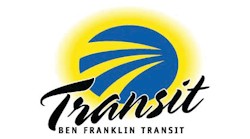Data proves microtransit is connecting underserved riders to public transit in Washington state
For many years, Ben Franklin Transit (BFT), which manages the transit network in Benton County and Franklin County in southeast Washington state, faced a problem: Traditional fixed-route transit was not adaptable enough to serve the mobility needs of residents in the lower-density cities of Kennewick, Pasco and Richland. Though BFT operates an extensive fixed-route network, under 30 percent of the area it serves lies within a reasonable walking distance (approximately 0.2 miles) of a bus stop.
In April 2020, the agency launched BFT CONNECT, a new microtransit service designed to expand the reach of the agency’s existing fixed-route transportation lines. Microtransit is shared transportation that allows riders to book on-demand trips. It uses software from TransitTech provider Via that dynamically routes vehicles to pick up and drop off riders where they are, instead of following a static schedule or fixed route. For $1.50 per ride, CONNECT provides flexible way for residents to access transit stops and other essential destinations.
BFT CONNECT’s flexibility has allowed the service to remain resilient.
“CONNECT allows BFT to provide service to low-density, low-demand areas that otherwise would not be cost-effective to serve with fixed route. It also acts as a barometer of demand the planning staff uses to determine if future fixed route service is needed in developing areas. From the customer perspective, it provides freedom, flexibility and assurance that multiple mobility options are available,” said BFT planner Kevin Sliger.
Extending coverage beyond fixed routes
CONNECT has experienced impressive ridership growth in the past two years, despite the community’s unpredictable travel needs during COVID-19. Compared to the second quarter of 2022 (April – June) to the same quarter in 2021, ridership has increased threefold while the number of unique riders has risen by 350 percent.
Data also points to a strong first- and last-mile use case, with nearly 80 percent of riders reporting they use this on-demand service to connect to other forms of transit. Four out of five top points of interest are transit hubs. Easier access to existing fixed-route bus lines was voted as one of the major benefits from using CONNECT, followed by reduced commuting time and cost savings.
In addition to linking people to existing transit, BFT CONNECT has expanded community members’ access to the entire Tri-Cities region. With the service, riders can book a trip whenever they need it, as long as the trip starts or ends at a designated point of interest in the service zone — transit hubs, schools, grocery stores and other key locations. Riders appreciate the new freedom to reach popular destinations that were not easily accessible by existing BFT bus routes. One rider said, “I could get the water and necessities home thanks only to BFT CONNECT.”

Krista Glotzbach
Krista helps cities, transit agencies and corporations define their goals and priorities for innovative transit services. Part consultant, part project manager and part business developer, Krista acts as a conduit between Via’s partners and the many operational teams involved in every partnership. Krista and her San Francisco-based partnerships team are helping drive innovation in public transit mobility for partners such as High Valley Transit and Golden Empire Transit, which are commingling operations and software across transit services to reduce costs and to better serve all riders across their regions. Prior to Via, Krista oversaw global business development at leading B2B tech companies, including Tamr, an enterprise data unification firm, and Vast, an automotive marketplace. Krista holds a B.A. in Economics and Japanese from Stanford University and an executive MBA from Harvard Business School.




